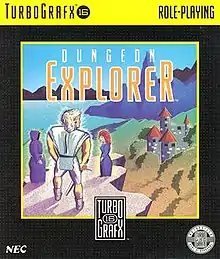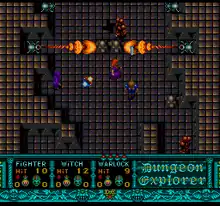Dungeon Explorer (1989 video game)
Dungeon Explorer[lower-alpha 1] is an action role-playing video game developed by Atlus and originally published by Hudson Soft for the TurboGrafx-16 in Japan on March 4, 1989 and later in North America by NEC on November 15 of the same year. The first installment in the eponymous franchise, the game is set in the land of Oddesia overrun by an alien race, where players assume the role of one of the eight main characters tasked with recovering the Ora stone to kill the alien king Natas. Co-directed by Kazutoshi Ueda and Yōsuke Niino, the title was created by most of the same team that would work on several projects such as later entries in the Megami Tensei series. Though it was initially launched for the TurboGrafx-16, it was later re-released through download services for various consoles.
| Dungeon Explorer | |
|---|---|
 | |
| Developer(s) | Atlus |
| Publisher(s) | |
| Director(s) | Kazutoshi Ueda Yōsuke Niino |
| Programmer(s) | Takashi Hasegawa Uni Arato |
| Artist(s) | Hideyuki Yokoyama Hiroshi Tsuji Yoshiaki Kitamura |
| Composer(s) | Tsukasa Masuko |
| Series | Dungeon Explorer |
| Platform(s) | TurboGrafx-16 |
| Release | |
| Genre(s) | Action role-playing game, dungeon crawl, hack and slash |
| Mode(s) | Single-player, multiplayer (up to five players via TurboTap) |
Dungeon Explorer garnered positive reception from critics during its initial release and is considered a pioneer title in the action RPG genre due to its co-operative multiplayer gameplay for up to five players,[1] but has since been met with a more mixed response from reviewers in recent years. It was followed by four entries: Dungeon Explorer II in 1993, Dungeon Explorer for Sega CD and Crystal Beans from Dungeon Explorer in 1995, as well as Dungeon Explorer: Warriors of Ancient Arts in 2007.
Gameplay

Dungeon Explorer is an action role-playing game with dungeon crawl and hack and slash elements that is played in a top-down perspective reminiscent of Gauntlet where players assume the role of one of the eight main characters tasked with recovering the Ora stone to ultimately kill the alien king Natas and restore peace to the land of Oddesia.[2][3][4] Each character belongs to a class (fighter, thief, warlock, witch, bishop, elf, bard, or gnome) and their abilities vary primarily in their black and white magic as well as statistics.[2] For example, the bishop's white potion heals nearby allies, whereas the bard's black potion has the ability to change the music. Special classes, like the princess and hermit, can also be unlocked via password as the game progresses.[3][4]
The players explore towns or fields to find a dungeon, which hosts a boss that must be defeated to advance and each boss leaves a crystal after their defeat, which cycles through four colors and corresponds with the character's stats (attack, strength, agility and intelligence).[2][3][4] Players can also increase their stats by defeating enemies or finding accessories through the map.[2][4] The game supports up to five players simultaneously but lives are shared between players and the game is over once they are lost.[2][3][4] The password system is also used to keep progress for each player.[2][4]
Synopsis
Dungeon Explorer centers on the quest of several heroes to find the Ora Stone for the king of Oddesia.[2] When the alien race that now rules the land invaded, the stone was hidden deep in the dungeons of the land by the King to keep it safe. Now, however, the king wants the players to recover the stone, which can bring life, light, and happiness to kill the alien king Natas.[4] The heroes progress through several different dungeons, fight fearsome beasts, and finally recover the Ora stone. Upon giving it to the king, however, the king reveals himself as Natas and steals the stone. A guard named Judas also betrays the heroes, but is defeated by them. The adventurers then chase and confront Natas, killing him and taking back the Ora stone, ushering in a time of peace.
Development and release
Dungeon Explorer was created by most of the same team that would work on several projects such as later entries in the Megami Tensei series, with Kazutoshi "Boo" Ueda and Yōsuke "HotRice" Niino acting as directors.[5] Takashi "Hieimon" Hasegawa and Uni "oooo" Arato served as programmers, while artists Hideyuki "Tonny" Yokoyama, Hiroshi "BLADOE" Tsuji and Yoshiaki "Sting" Kitamura were responsible for the pixel art.[5] The soundtrack was composed by Tsukasa "Dosanko Macco" Masuko.[5] Other people also collaborated in its development, with Star Parodier designer Tadayuki Kawada being also involved with the project as his first work in the video game industry, supervising the graphics and game balancing.[5][6]
Dungeon Explorer was first released for the TurboGrafx-16 in Japan by Hudson Soft on March 4, 1989 and later in North America by NEC on November 15 of the same year.[7][8] The game was later re-released for the Wii's Virtual Console in Europe on December 8, 2006 and in North America on January 8, 2007.[9] The Wii version can be played with 5 players, with at least one person using a GameCube controller.[4] The title was also re-released on the Japanese and North American PlayStation Network.[10]
Reception
| Publication | Score |
|---|---|
| Aktueller Software Markt | 9 / 12[11] 11 / 12[11] |
| CVG | 94%[12] |
| Dragon | |
| EGM | 28 / 40[7] |
| Famitsu | 29 / 40[8] |
| HobbyConsolas | 84 / 100[14] |
| Tilt | 15 / 20[15] |
| ACE | 890 / 1000[16] |
| Marukatsu PC Engine | 27 / 40[17] |
| PC Engine Fan | 23.66 / 30[18] |
| Power Play | 75 / 100[19] |
| TurboPlay |
Legacy
A sequel to the game, Dungeon Explorer II, was later released for the TurboGrafx-CD console in 1993.[27][28] A heavily modified port of Dungeon Explorer II was made for the Super Famicom, titled Crystal Beans from Dungeon Explorer, and was released in Japan in 1995.[29]
There was also a Sega CD game which goes by the name of Dungeon Explorer.[30][31] It is related to the series, but not a port of any previous game, and very different from the others. Developed by Westone, Dungeon Explorer for the Sega CD is far closer to Gauntlet than other games in the series. Weapons and armor may be bought with the gold found in dungeons.
In 2007, two related games, again different from the original titles, were released to coincide with the release of the original Dungeon Explorer on the Wii's Virtual Console. Both Dungeon Explorer: Meiyaku no Tobira and Dungeon Explorer: Jashin no Ryouiki were released for the PlayStation Portable and Nintendo DS respectively on November 15, 2007. Both games were localized but released as Dungeon Explorer: Warriors of Ancient Arts.[32][33]
References
- Aihoshi, Richard (8 January 2008). "Dungeon Explorer: Warriors of Ancient Arts Interview - Hudson tells us about bringing back a classic property with two different versions for the PSP and DS platforms". RPG Vault. IGN. Archived from the original on 6 December 2008. Retrieved 13 February 2020.
- Dungeon Explorer manual (TurboGrafx-16, US)
- "Dungeon Explorer". TurboForce. No. 1. Sendai Publishing. June 1992. pp. 16–17.
- Kalata, Kurt (December 13, 2009). "Dungeon Explorer". Hardcore Gaming 101. Archived from the original on May 30, 2019. Retrieved 2020-02-13.
- Atlus (1989). Dungeon Explorer (TurboGrafx-16). NEC. Level/area: Staff.
- "ゲームデザ イナー大全集". Famitsu (in Japanese). No. 151. ASCII Corporation. November 8, 1991. pp. 85–100. (Translation by Shmuplations. Archived 2020-05-20 at the Wayback Machine).
- Harris, Steve; Semrad, Ed; Nauert, Donn; Stockhausen, Jim (November 1989). "Review Crew - Dungeon Explorer". Electronic Gaming Monthly. No. 4. Sendai Publishing. p. 12.
- "ダンジョンエクスプローラー (PCエンジン) - ファミ通.com". Famitsu (in Japanese). Kadokawa Game Linkage. 2020. Archived from the original on 2019-05-23. Retrieved 2020-02-13.
- Weiss, Brett Alan (8 January 2007). "Dungeon Explorer [Virtual Console] - Overview". AllGame. All Media Network. Archived from the original on 14 November 2014. Retrieved 13 February 2020.
- Weiss, Brett Alan (3 June 2011). "Dungeon Explorer [PlayStation Network] - Overview". AllGame. All Media Network. Archived from the original on 14 November 2014. Retrieved 13 February 2020.
- Braun, Peter; Kleimann, Manfred (August–September 1989). "Konsolen - "Rollenadvencade"". Aktueller Software Markt (in German). No. 34. Tronic Verlag. p. 70.
- Rignall, Julian (June 1989). "PC Engine - Mean Machines: Dungeon Explorer". Computer and Video Games. No. 92. Future Publishing. pp. 90–91. Archived from the original on 2016-04-03. Retrieved 2020-02-13.
- Lesser, Hartley; Lesser, Patricia; Lesser, Kirk (November 1990). "The Role of Computers - Reviews - Dungeon Explorer" (PDF). Dragon. No. 163. TSR, Inc. p. 49. Archived (PDF) from the original on 2016-03-22. Retrieved 2020-02-13.
- Herranz, Sonia (July 1993). "Lo Más Nuevo - Turbo Grafx: Dungeon Explorer – La Piedra Mágica". Hobby Consolas (in Spanish). No. 22. Hobby Press. pp. 120–121.
- Huyghues-Lacour, Alain (November 1989). "Rolling Softs - Dungeon Explorer (Console NEC, carte Hudson soft)". Tilt (in French). No. 71. Editions Mondiales S.A. p. 87.
- Rignall, Julian (July 1989). "Screen Test - Dungeon Explorer: PC Engine out-Gauntlets Gauntlet". ACE. No. 22. EMAP. p. 56. Archived from the original on 2016-03-26. Retrieved 2020-02-13.
- "ダンジョンエクスプローラー". Marukatsu PC Engine (in Japanese). Kadokawa Shoten.
- "PC Engine All Catalog '93 10月号特別付録 - ダンジョンエクスプローラー". PC Engine Fan (in Japanese). Vol. 6 no. 10. Tokuma Shoten. October 1, 1993. p. 43.
- Hengst, Michael (August 1989). "Videospiele-Tests: Dungeon Explorer". Power Play (in German). No. 17. Future Verlag. p. 60.
- Nauert, Donn (February–March 1991). "TurboPlay Rates the Games - Dungeon Explorer". TurboPlay. No. 5. L.F.P., Inc. p. 26.
- "TurboPlay Rates the Games - Volume 2: Dungeon Explorer". TurboPlay. No. 11. L.F.P., Inc. February–March 1992. p. 27.
- Reed, Kristan (January 24, 2007). "Virtual Console: TurboGrafx-16 - PC-Ingenuity?". Eurogamer. Gamer Network. Archived from the original on July 14, 2019. Retrieved 2020-02-13.
- Bohn-Elias, Alexander (February 1, 2007). "Retro auf Raten - Wii Virtual Console – Teil 2: Mit Siebenmeilenstiefeln in Richtung 16Bit - TurboGrafx-16". Eurogamer (in German). Gamer Network. Archived from the original on March 7, 2016. Retrieved 2020-02-13.
- Mueller, Greg (10 April 2007). "Dungeon Explorer Review - Dungeon Explorer's rudimentary design and unforgiving difficulty make it a tedious and often frustrating game". GameSpot. CBS Interactive. Archived from the original on 13 February 2020. Retrieved 13 February 2020.
- Birnbaum, Mark (February 22, 2007). "Dungeon Explorer Review - Some short-lived, shoot 'em up fun". IGN. Ziff Davis. Archived from the original on April 14, 2019. Retrieved 2020-02-13.
- McFerran, Damien (December 8, 2006). "Dungeon Explorer Review (TG-16) - Dungeon Explorer is a multiplayer action/role-playing game where up to five players can play at the same time". Nintendo Life. Nlife Media. Archived from the original on April 22, 2019. Retrieved 2020-02-13.
- "ダンジョンエクスプローラーII (PCエンジン) - ファミ通.com". Famitsu (in Japanese). Kadokawa Game Linkage. 2020. Archived from the original on 2019-07-08. Retrieved 2020-08-08.
- Lagan, Jack (September–October 1993). "Reviews (Duo/TG-16) - Dungeon Explorer II". DuoWorld. No. 2. Larry Flynt Publications. pp. 14–15.
- Kalata, Kurt (December 17, 2008). "Crystal Beans From Dungeon Explorer". Hardcore Gaming 101. Archived from the original on 18 October 2019. Retrieved 2020-08-08.
- "News • Previews Internationales: Dungeon Explorer (Megadrive - Hudson)". Joypad (in French). No. 39. Yellow Media. February 1995. p. 39.
- "Finals - Sega CD - Dungeon Explorer". Next Generation. No. 5. Imagine Media. May 1995. p. 95. Archived from the original on 2019-01-05. Retrieved 2020-08-08.
- Kalata, Kurt (17 December 2008). "Dungeon Explorer (DS)". Hardcore Gaming 101. Archived from the original on 20 October 2019. Retrieved 2020-08-09.
- Kalata, Kurt (18 December 2008). "Dungeon Explorer (PSP)". Hardcore Gaming 101. Archived from the original on 19 December 2019. Retrieved 2020-08-09.